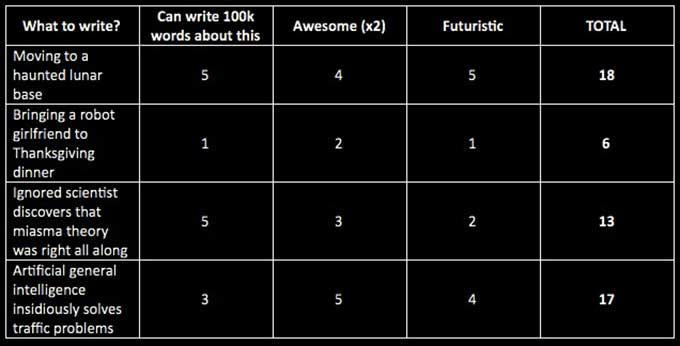
You decided to read this article on a whim, and I'm glad you did. Not all decisions require a decision matrix. I'm an author, so I use decision matrices to methodically decide what's going to happen in a story. After completing a decision matrix, I'm satisfied with my choice and I can concentrate on writing about the option I selected.
In preparing to describe how I use decision matrices to make decisions, I noticed that Boing Boing's primary reference to decision matrices is highlighting another website's flowchart. It's a great flowchart. It's just not a decision matrix.
Decision matrices start with a matrix, in this context defined as a rectangular array of elements. A blank spreadsheet is fine. If you abhor spreadsheets, use any other medium you can make rows and columns with, but keep in mind that the decision at the end involves some elementary math. This is an example of customizations I'll suggest while I'm explaining decision matrices, to make the technique work well for you.
Now that you have an empty matrix, define the problem you want to solve. If you're into the 5 why's technique, or if you've never tried it before, this is a good place to use it. If you'd rather meditate or walk or shower to let your subconscious define the problem, that may work better for you. A decision matrix is a tool, so make sure you're applying it to the question which will get you the results you want.
A simple question which a decision matrix can answer is "What should I write about?" List every possible option in the first column. For fiction, I generally agree with Seth Godin: "If you come up with 20 bad ideas, you'll have a good idea" (2010 interview). This is the brainstorming stage, so if you have time, list every remotely plausible idea and eliminate bad ones later.
However, we're in a hurry and we need our writing topic now. Maybe we procrastinated planning for NaNoWriMo. Let's start with four options to choose between:
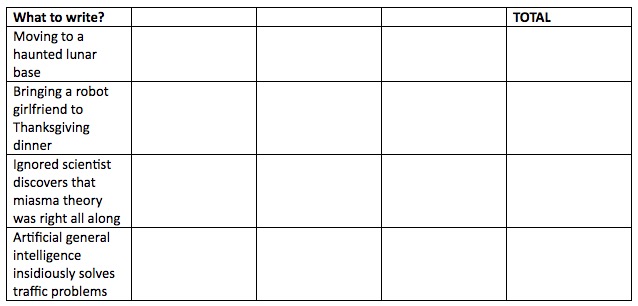
Note that this is a tiny decision matrix. A baby. It is cute. My cell count is usually closer to 300. Also note that the above is an excellent example of using a decision matrix to choose between less than ideal options.
Next, list criteria by which to judge your options. I use subjective criteria, but if you want to operationalize concepts and go the objective route, you can. Also, if you don't mind limiting your brainstorming possibilities by listing criteria, you can complete this step before filling the first column with options.
Put the criteria in the first row:
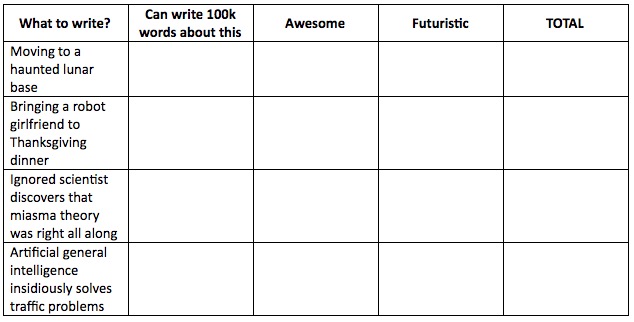
I fill in my decision matrices by column, so I can compare, say, how awesome haunted lunar bases are to the awesomeness of robot girlfriends. Rating each idea completely before moving on to the next row lets you build a more detailed mental model of how that idea would work before you rate the next one. Do what makes sense to you.
I rate how well each criterion applies to the idea on a 1-5 scale, with 5 being YES! and 1 being NO! Note that we are rating options, not ranking them. Reuse ratings as often as needed.
The table below indicates that I, personally, couldn't write 100,000 words about bringing a robot girlfriend to dinner. Moon Ghosts and Miasma was Right! sound totally doable. I'm already in the process of writing the best 300,000 words I can about AI, so I'd have to read a lot more before I have enough AI ideas for another 100,000 words. It's still a fun topic, though, so it gets a 3 on that criterion.
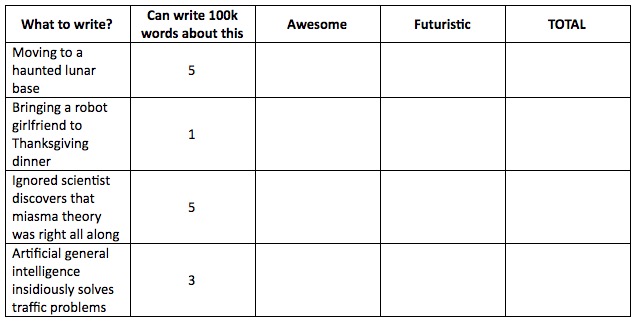
I weight the most important criteria with a multiplier. Since I write science fiction, awesomeness (both formal and colloquial) is essential. If I happen across a sufficiently awesome idea, I can research and get excited enough about it to write 100,000 words. The multiplier also prevents me from writing 100,000 words on a topic I enjoy, but which few other people are interested in (i.e. it isn't colloquially "awesome").
Now, let's make the decision by adding the rows. The row with the highest total is your best option.
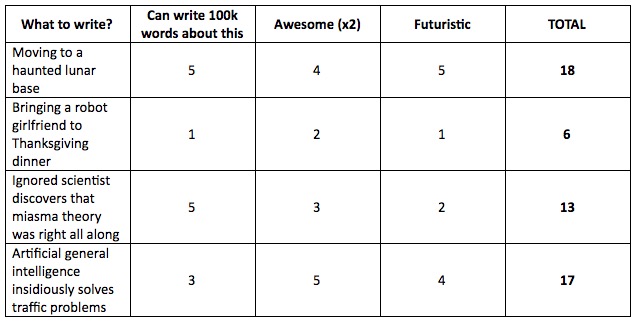
For even better results, combine your highest rated options where possible. The "haunted" lunar base our protagonist moved to could very well host an AGI. The AGI reaches its limit watching humans jam up in the corridors, so it starts scaring people into efficient traffic patterns and killing the worst flying car drivers. Will our protagonist stop it, or give it access to every city in the solar system? That's a better story than either concept would've been individually.
R.E. Stearns wrote her first story on an Apple IIe computer and still kind of misses green text on a black screen. She went on to annoy all of her teachers by reading books while they lectured. Eventually she read and wrote enough to earn a master's degree in curriculum and instruction from the University of Central Florida. She is hoping for an honorary doctorate. When not writing or working, R.E. Stearns reads, plays PC games, and references Internet memes in meatspace. She lives near Orlando, FL with her husband/computer engineer and a cat.
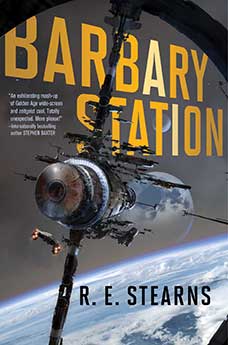 About R.E. Stearn's new novel, Barbary Station: Two engineers hijack a spaceship to join some space pirates—only to discover the pirates are hiding from a malevolent AI. Now they have to outwit the AI if they want to join the pirate crew—and survive long enough to enjoy it. Adda and Iridian are newly minted engineers, but aren’t able to find any work in a solar system ruined by economic collapse after an interplanetary war. Desperate for employment, they hijack a colony ship and plan to join a famed pirate crew living in luxury at Barbary Station, an abandoned shipbreaking station in deep space. But when they arrive there, nothing is as expected. The pirates aren’t living in luxury—they’re hiding in a makeshift base welded onto the station’s exterior hull. The artificial intelligence controlling the station’s security system has gone mad, trying to kill all station residents and shooting down any ship that attempts to leave—so there’s no way out. Adda and Iridian have one chance to earn a place on the pirate crew: destroy the artificial intelligence. The last engineer who went up against the AI met an untimely end, and the pirates are taking bets on how the newcomers will die. But Adda and Iridian plan to beat the odds. There’s a glorious future in piracy…if only they can survive long enough.
About R.E. Stearn's new novel, Barbary Station: Two engineers hijack a spaceship to join some space pirates—only to discover the pirates are hiding from a malevolent AI. Now they have to outwit the AI if they want to join the pirate crew—and survive long enough to enjoy it. Adda and Iridian are newly minted engineers, but aren’t able to find any work in a solar system ruined by economic collapse after an interplanetary war. Desperate for employment, they hijack a colony ship and plan to join a famed pirate crew living in luxury at Barbary Station, an abandoned shipbreaking station in deep space. But when they arrive there, nothing is as expected. The pirates aren’t living in luxury—they’re hiding in a makeshift base welded onto the station’s exterior hull. The artificial intelligence controlling the station’s security system has gone mad, trying to kill all station residents and shooting down any ship that attempts to leave—so there’s no way out. Adda and Iridian have one chance to earn a place on the pirate crew: destroy the artificial intelligence. The last engineer who went up against the AI met an untimely end, and the pirates are taking bets on how the newcomers will die. But Adda and Iridian plan to beat the odds. There’s a glorious future in piracy…if only they can survive long enough.


